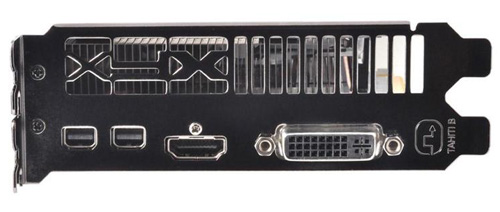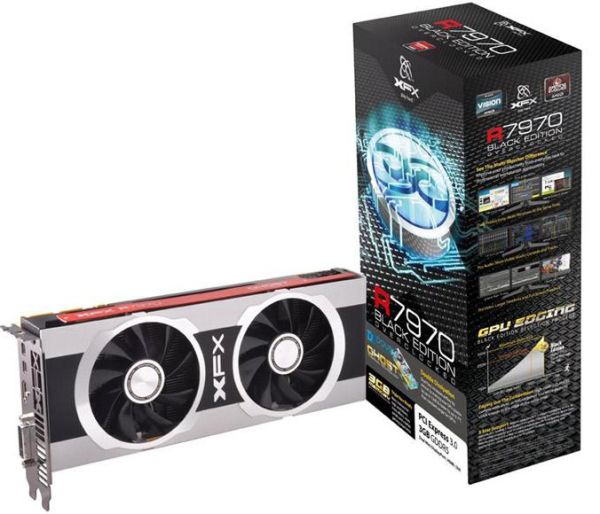XFX’s Radeon HD 7970 Black Edition Double Dissipation: The First Semi-Custom 7970
by Ryan Smith on January 9, 2012 6:00 AM ESTTraditionally the launch of a next-generation high-end video card has been a staggered process. In the name of getting cards out as soon as possible the first cards are almost always reference cards coming preassembled straight from AMD or NVIDIA, which are then touched up in the livery of their partners before being boxed and sold. Only later on – particularly when there’s a solid supply of GPUs – can partners acquire individual parts and put together their custom designs.
But as it’s turning out the Radeon HD 7970 isn’t going to be a traditional launch. In a rare move AMD has loosened the leash on their partners just a bit, and as a result we’re seeing semi-custom cards planned for launch earlier than usual. XFX looks to be the first partner to take advantage of this more liberal policy, as alongside the reference cards being launched today they’re launching their first semi-custom 7970s.
| AMD GPU Specification Comparison | ||||||
| XFX Radeon HD 7970 Black Edition | AMD Radeon HD 7970 | AMD Radeon HD 6970 | AMD Radeon HD 6870 | |||
| Stream Processors | 2048 | 2048 | 1536 | 1120 | ||
| Texture Units | 128 | 128 | 96 | 56 | ||
| ROPs | 32 | 32 | 32 | 32 | ||
| Core Clock | 1000MHz | 925MHz | 880MHz | 900MHz | ||
| Memory Clock | 1.425GHz (5.7GHz effective) GDDR5 | 1.375GHz (5.5GHz effective) GDDR5 | 1.375GHz (5.5GHz effective) GDDR5 | 1.05GHz (4.2GHz effective) GDDR5 | ||
| Memory Bus Width | 384-bit | 384-bit | 256-bit | 256-bit | ||
| Frame Buffer | 3GB | 3GB | 2GB | 1GB | ||
| FP64 | 1/4 | 1/4 | 1/4 | N/A | ||
| Architecture | GCN | GCN | VLIW4 | VLIW5 | ||
| Transistor Count | 4.31B | 4.31B | 2.64B | 1.7B | ||
| Manufacturing Process | TSMC 28nm | TSMC 28nm | TSMC 40nm | TSMC 40nm | ||
| Price Point | $599 | $549 | $350 | $160 | ||
XFX has 4 7970s planned; half of which are using AMD’s reference cooler, and the other half using XFX’s twin fan Double Dissipation cooler. As is traditional with the first wave of customized cards, all of these cards are semi-custom as XFX is using AMD’s reference PCB. Fully custom cards will come farther down the line. Of these 4 cards, 2 of them will be launching today: XFX’s Core Edition pure reference card, and their customized Black Edition Double Dissipation model, which features both a factory overclock and XFX’s custom cooler. It’s the Black Edition Double Dissipation we’ll be looking at today.
| XFX Radeon HD 7970 Lineup | ||||||
| XFX Radeon HD 7970 Black Edition Double Dissipation | XFX Radeon HD 7970 Black Edition | XFX Radeon HD 7970 Double Dissipation | XFX Radeon HD 7970 Core Edition | |||
| Product Number | FX-797A-TDBC | FX-797A-TNBC | FX-797A-TDFC | FX-797A-TNFC | ||
| Core Clock | 1000MHz | 1000MHz | 925MHz | 925MHz | ||
| Memory Clock | 1.425GHz (5.7GHz effective) GDDR5 | 1.425GHz (5.7GHz effective) GDDR5 | 1.375GHz (5.5GHz effective) GDDR5 | 1.375GHz (5.5GHz effective) GDDR5 | ||
| Cooler | Double Dissipation | Reference | Double Dissipation | Reference | ||
| Price Point | $599 | N/A | N/A | $559 | ||
The 7970 Black Edition Double Dissipation is XFX’s top 7970 card. XFX is binning the boards they receive from AMD to give their Black Edition lineup a moderately impressive launch day overclock. The 7970 BEDD ships at 1000MHz core (8% overclock) and 5.7GHz memory (4% overclock), on what’s proving to be a rather overclockable design for AMD. Notably they’re doing this without any extra voltage – both our reference and BEDD 7970s run at 1.17v – which means the BEDD’s power consumption is only marginally higher than the reference 7970.
Along with the factory overclock the BEDD features XFX’s Double Dissipation cooler. Like the 7970 reference cooler XFX is using a vapor chamber at the base of their heatsink to draw heat from the Tahiti GPU, which then leads to an aluminum heatsink that runs almost the entire length of the card. Airflow is provided by a pair of fans sitting on top of the heatsink, similar to a number of other double fan designs we’ve seen over the years. Meanwhile like the heatsink, the casing is also made out of aluminum, specifically brushed aluminum. Finally, XFX is using a custom bracket with their logo cut into it – they claim that this improves airflow, but compared to any other changes the difference would be minimal at best.
Compared to AMD’s reference blower design the biggest difference here is that like other twin fan designs the Double Dissipation cooler is fundamentally an open air internal exhaust design. This allows XFX to achieve a similar level of cooling as AMD’s design, but with less noise. The tradeoff of course is that with an internal exhaust case cooling becomes much more critical as the BEDD will be dissipating most of the 250W of heat a 7970 generates under load into the case rather than outside of it.
Because the card is based on an AMD PCB, the dimensions of the card are similar to the reference 7970. The PCB itself is 10.5” just like the reference card, but XFX’s cooler isn’t quite as long, shaving off roughly 0.3” compared to the reference card and making the entire package only 10.65” long. Meanwhile at the front of the card, since this is an AMD PCB the port layout is identical: 1 DL-DVI port, 1 HDMI port, and 2 miniDP ports, situated below XFX’s logo on their custom bracket.

Moving on to the packaging, XFX packages only a few additional items with the BEDD, and as a result the box not much bigger than the card. Inside you’ll find the usual driver CD and quick start guide, along with a metal XFX case badge, a mid-length CrossFire bridge, and a passive HDMI to SL-DVI adaptor. It’s interesting to note that XFX has not included the more expensive active miniDP to SL-DVI adaptor, contrary to AMD’s earlier claims that all 7970s would ship with one, so the BEDD is only good for driving 2 DVI monitors out of the box. Finally, XFX is offering a base 2 year warranty on the BEDD, which can be extended to a lifetime warranty (ed: not a double lifetime warranty) by registering the card within 30 days of purchasing it.
The MSRP on the BEDD is $599, $50 over the $549 MSRP for the reference cards. Even with the higher price it looks to either be popular or in short supply – we saw the card sell out at Newegg before our NDA even expired.
| Winter 2011 GPU Pricing Comparison | |||||
| AMD | Price | NVIDIA | |||
| $750 | GeForce GTX 590 | ||||
| Radeon HD 6990 | $700 | ||||
| XFX Black Edition Double Diss. | $599 | ||||
| Radeon HD 7970 | $549 | ||||
| $500 | GeForce GTX 580 | ||||
| Radeon HD 6970 | $350 | GeForce GTX 570 | |||
| Radeon HD 6950 2GB | $250 | ||||
| $240 | GeForce GTX 560 Ti | ||||
| Radeon HD 6870 | $160 | ||||












93 Comments
View All Comments
radium69 - Monday, January 9, 2012 - link
Maybe it's me, but this looks VERY classy!Not gimmicky and plasticky but very tight and sexy!
I'm going to keep an eye out for this card. hope they stick more with the allumium design.
RubyX - Monday, January 9, 2012 - link
Couldn't you fix the idle noise issue by just changing the fan speed via software? Or is that not possible with this card for some reason?Ryan Smith - Monday, January 9, 2012 - link
The lowest fan speed with AMD's fan profile is 20%, which is where it already settles to at idle. It's not possible to go below 20% right now, hence 43dB really is as quiet as the DD cooler can get.dj christian - Tuesday, January 10, 2012 - link
Well i can go to 0% in MSI Afterburner. But the fan never stops no matter how low you put itRyan Smith - Tuesday, January 10, 2012 - link
Afterburner is just a frontend to Overdrive in this case. It can't take the fan any lower than Overdrive will allow, and that's 20%.james.jwb - Thursday, January 12, 2012 - link
what about speedfan?cactusdog - Monday, January 9, 2012 - link
I'm going to wait for a better quality non-reference cooler like the Asus DCUII, MSI Twin Frosr, Sapphire vapourX, Gigabyte Windforce.If you can hear the card at idle that is a disaster, especially when it costs $60 more
LB-ID - Monday, January 9, 2012 - link
I completely agree. Sapphire's VaporX cards have spoiled me, I won't settle for less as far as acoustic management is concerned.Artifex28 - Tuesday, January 10, 2012 - link
Got lucky year back or so and got a VaporX 5870 instead of my original 5850. Can´t complain. Excellent card!In my case it´s an external HDD fan that makes the most noise and this pulsating hum...
piroroadkill - Monday, January 9, 2012 - link
I agree that it is pathetic you can hear it at idle, especially given ATI's massive gains in the areas of idle power. Massive gains.I use a custom fan curve through MSI Afterburner on my Radeon 6950 Twin Frozr III, and it is simply inaudible at idle.